
So what can you do with a science degree?
Meet science grad Allyson Hindle, Biology/Zoology major [B.Sc. (Hons)/00, M.Sc./02], Comparative Animal Physiologist, Harvard Medical School
She has battled simulated floods in astronaut training and tracked 350 kilogram Weddell seals in the Antarctic. But there is one experience that sticks out in Allyson Hindle’s mind when it comes to heart-thumping moments as a scientist.
The year is 1999 and Hindle is working on her honours thesis at the U of M: how short-tailed shrews regulate their body temperature. This requires catching shrews at night in the woods at FortWhyte Alive—not usually a problem, but Hindle has just watched The Blair Witch Project, a cult horror film in which three students disappear in a murky forest and are assumed to have been offed by ghostly forces.
“The flashlight in the forest, seeing just trees all around you,” recalls Hindle, laughing now about the fear she felt.
Nevertheless, Hindle caught her shrews and completed her thesis before going on to more adventures.
“I guess I don’t mind that being shared with the world: that was a really poor film choice,” she says.
Hindle’s work as a comparative animal physiologist focusses on what we can learn from animals living in harsh environments. She works for Harvard Medical School’s department of anesthesiology and principally studies diving animals like muskrats, water shrews and seals.
“They’re able to manage their oxygen levels and turn off and on blood flow to specific organs as they need those organs to be perfused,” says Hindle. “These are all things in critical care that we would really like to have a better handle on.”
Hindle also investigates how animals survive the cold. In one recent study involving the thirteen-lined ground squirrel, Hindle found these tiny rodents were able to actually build muscle mass towards the end of their hibernation—despite being asleep and not eating. This research could eventually help us better care for people who are bedridden and losing muscle mass, despite receiving nutrition.
“What we need to do is identify what genes in ground squirrels are important in changing the programing of the muscle from loss to building,” says Hindle. “Then generally, we could figure out how to artificially regulate those genes in humans.”
After finishing her studies at the University of Manitoba, Hindle headed south to Texas A&M University for her doctorate. She then joined the University of British Columbia as a fellow to study how fishing is affecting Steller sea lion populations on the West Coast.
“Having now been to a number of other places, I really see I had a great set of courses and a great set of professors at the U of M,” says Hindle. “I learned a lot. The education was really broad and useful, and it helped me be successful and pick up things as I went through to other places. I’m always really thankful for the quality of education I received.”
In 2009, Hindle was selected by the Canadian Space Agency to try out for its astronaut-training program because of her experience working in inhospitable locations like the Antarctic. She underwent physical fitness tests similar to those at a boot camp, as well as problem-solving evaluations. The latter involved visiting the Royal Canadian Navy’s Damage Control School near Halifax, where Hindle was tested on managing disasters like a flooding ship. She was the last woman to make the final 12 before two winnings candidate were chosen. It was almost the fulfillment of a dream—at least, a childhood dream.
“When I was young, I was either going to be a ballerina or an astronaut,” says Hindle. “That morphed a little bit when I was growing up. I ended up in zoology and I just really loved it. I realized I could be a wildlife biologist.”
One who knows how to get the word out, Hindle is passionate about scientific research and believes her community can do better when it comes to explaining their work to the public. She was recently chosen for a two-year fellowship with the American Physiological Society in which she’ll study how scientists can better communicate their discoveries. That’s important; she wants her work to provide context when it comes to protecting the environment because her studies involve examining not just a species’ ability to deal with a difficult environment, but a changing one as well.
“Is there a point where we can predict when an animal is actually going to be in trouble?” asks Hindle. “Because that’s what policy needs to understand: how far can we push this mess before we’re actually really doing damage.”
Still, Hindle isn’t trying to spend all her time in discussions indoors. Slipping on her gear and heading out to do fieldwork is still the activity she relishes most about her job.
“When you work with humans and mice, they come to you; the mice are delivered,” says Hindle. “You lose that ability to actually see environments and animals in them. I just love the opportunity to actually get out to where the animals are.”
Explore more science alumni stories







